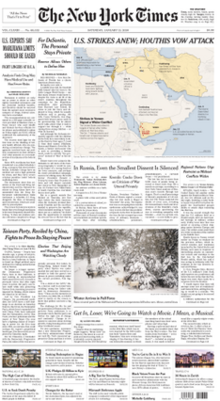News Articles Can Be Fun For Everyone
News Articles Can Be Fun For Everyone
Blog Article
Get This Report on News Articles
Table of ContentsNot known Details About News Articles Some Known Questions About News Articles.What Does News Articles Mean?Getting My News Articles To WorkThe News Articles Statements
Excellent knowledge of different subjects provides pupils an one-upmanship over their peers. Despite the fact that digital and social media are readily obtainable, we must not fail to remember how crucial it is to check out the papers. Moms and dads have to attempt and instill the practice of reading a paper as an everyday routine to proceed the tradition of the revered print medium.Newspaper article additionally consist of at the very least one of the complying with vital attributes about the designated audience: distance, prominence, timeliness, human interest, strangeness, or repercussion. The associated term journalese is in some cases utilized, usually pejoratively, to describe news-style writing. One more is headlinese. Newspapers typically follow an expository writing design.
Within these limitations, newspaper article also intend to be comprehensive. Other factors are involved, some stylistic and some obtained from the media type. Amongst the larger and more revered newspapers, fairness and balance is a significant factor in presenting details. Discourse is normally restricted to a different area, though each paper might have a various overall angle.
Papers with an international audience, as an example, tend to use an extra official design of creating. The specific selections made by an information outlet's editor or content board are frequently accumulated in a design guide; common style guides include the and the United States News Style Book. The primary goals of information writing can be summed up by the ABCs of journalism: accuracy, brevity, and quality.
The Definitive Guide to News Articles
As a regulation, journalists will certainly not make use of a long word when a brief one will certainly do. They make use of subject-verb-object construction and vibrant, active prose (see Grammar). They use narratives, instances and allegories, and they hardly ever rely on generalizations or abstract concepts. Information authors try to avoid using the same word greater than once in a paragraph (often called an "echo" or "word mirror").
Nonetheless, headings occasionally omit the subject (e.g., "Jumps From Watercraft, Catches in Wheel") or verb (e.g., "Feline woman fortunate"). A subhead (additionally subhed, sub-headline, subheading, subtitle, deck or dek) can be either a secondary title under the primary heading, or the heading of a subsection of the post. It is a heading that comes before the major message, or a group of paragraphs of the major text.

Added billboards of any of these kinds may appear later on in the post (especially on succeeding web pages) to lure additional reading. Such billboards are also used as tips to the post in other areas of the publication or website, or as ads for the item in other publication or websites. Typical structure with title, lead paragraph (recap in bold), other paragraphs (information) and contact info.

Instance of a hard-lead paragraph NASA is suggesting one more space project. The firm's spending plan demand, announced today, included a plan to send an additional mission to the Moon. This time around additional reading the firm wishes to establish a long-lasting facility as a jumping-off factor for other space experiences. The budget requests approximately $10 billion for the job.
An "off-lead" is the 2nd most vital front page news of the day. To "hide the lead" is to begin the short article with background info or details of second relevance to the visitors, requiring them to check out even more deeply into an article than they need to have to in order to uncover the necessary factors.
More About News Articles
Usual usage is that one or two sentences each create their own paragraph. Reporters generally describe the organization or structure of a newspaper click reference article as an upside down pyramid. The crucial and most interesting components of a tale are put at the start, with sustaining info following in order of diminishing significance.
It allows individuals to check out a topic to only the deepness that their curiosity takes them, and without the imposition of details or nuances that they can consider irrelevant, but still making that details readily available to extra interested visitors. The inverted pyramid structure additionally makes it possible for write-ups to be cut to any type of arbitrary length throughout format, to suit the area available.
Some writers begin their stories with the "1-2-3 lead", yet there are several kinds of lead readily available. A kicker can refer to numerous things: The last story in the information program; a "delighted" story to end the show.
Longer short articles, such as magazine cover short articles and the pieces that lead click to find out more the within areas of a newspaper, are called. Function stories differ from straight news in several means. Foremost is the lack of a straight-news lead, a lot of the time. As opposed to providing the essence of a tale in advance, feature authors may attempt to tempt visitors in.
The 9-Minute Rule for News Articles
The journalist often details interactions with meeting topics, making the item much more individual. An attribute's first paragraphs often associate a fascinating moment or event, as in an "unscientific lead". From the particulars of an individual or episode, its view rapidly widens to generalities about the tale's subject. The section that signals what a feature is around is called the or signboard.

The Editor's Tool kit: A Referral Overview for Beginners and Professionals (2001) Allan M. Siegal and William G. Connolly. The New York Times Guidebook of Design and Usage: The Official Design Guide Utilized by the Writers and Editors of the Globe's Most Authoritative Paper (2002) M. L. Stein, Susan Paterno, and R.
Report this page